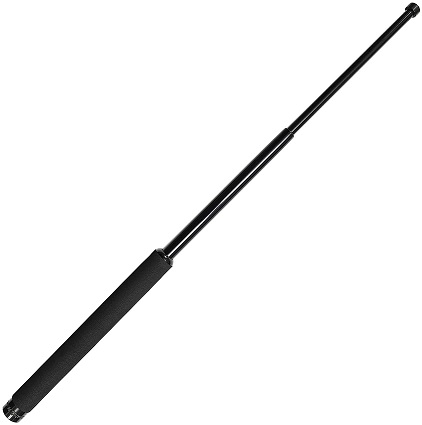Police Baton – Non Lethal Weapon
Martial arts are one of the most popular forms of physical activity that people indulge in. They not only help in maintaining a healthy lifestyle but also teach important self-defense techniques. Among the many martial arts weapons used, the police baton stands out for its versatile and effective use in law enforcement.
The Police Baton is an impressive martial arts weapon that is popular among law enforcement personnel, security guards, and martial arts practitioners. It is a long, cylindrical stick made of metal, rubber, or wood that is used for striking, jabbing, and blocking. This weapon is known for its versatility and effectiveness in close combat situations.
In this article, we will take a closer look at the Police Baton and how it is used as a martial arts weapon. We will also provide you with some useful tips on how to choose the right Police Baton for your training and defense needs.
The History of the Police Baton
The Police Baton has been used as a law enforcement tool for centuries. It was first used by the military in ancient times as a means of defense against enemies. Over time, it evolved into a tool for law enforcement and self-defense.
The modern Police Baton was introduced in the 1800s as a replacement for the sword, which was no longer practical for law enforcement purposes. The first Police Baton was made of wood and was used mainly for crowd control. Today, the Police Baton has evolved into a versatile and effective tool used for both law enforcement and martial arts training.
Types of Batons
There are several types of Police Batons available in the market today. The most common types include:
- Straight Baton: This is the most traditional type of Police Baton. It is a straight, cylindrical stick made of metal or wood. It is usually between 16 to 36 inches long and is used for striking, jabbing, and blocking.
- Expandable Baton: This is a more modern type of Police Baton. It is a collapsible stick that can be easily carried and concealed. It is usually made of metal and can be extended to a length of up to 26 inches.
- Side-Handle Baton: This type of Police Baton (similar to a Tonfa) has a side handle that provides better grip and control. It is used mainly for striking and blocking.
Straight batons of rubber have a softer impact. Some of the kinetic energy bends and compresses the rubber and bounces off when the object is struck.
Rubber batons are not very effective when used on the subject’s arms or legs, and can still cause injury if the head is struck. That is why most police departments have stopped issuing them.
The Russian police standard-issue baton is rubber, except in places such as Siberia, where it can be cold enough that the rubber may become brittle and break if struck. The traffic baton is red to make it more visible as a signaling aid in directing traffic. In Russia, traffic batons are striped in black and white for the same reason, and in Sweden they are white.
Until the mid-1990s, British police officers carried traditional wooden truncheons of a sort that had changed little from Victorian times. Since the late 1990s, the collapsible baton is issued except for public order duties, where a fixed, acrylic baton is used. Side-handled batons were issued for a while, but fell out of favour.
In New York, the police used to use two kinds of batons depending on the time. The one for daytime was called a day-stick and was 280 mm (11 in) in length. Another baton, that was used at night, was 660 mm (26 in) long and called a night-stick, which is the origin of the word “nightstick”. The night-stick was longer so it could provide extra protection which was thought to be necessary at night
How to Choose the Right Baton
When choosing a Baton, there are several factors to consider. These include:
- Material: Batons are usually made of metal, rubber or wood. Each material has its own advantages and disadvantages. Metal Batons are the most durable but can be heavy. Rubber Batons are lightweight and provide a better grip but are not as durable as metal Batons. Wood Batons are lightweight and durable but can break easily.
- Length: The length of the Baton is an important factor to consider. Longer Batons are more effective for striking and blocking, but they can be heavy and difficult to carry. Shorter Batons are easier to carry but are less effective in close combat situations.
- Weight: The weight of the Baton is another important factor to consider. A heavier Baton provides more striking power, but it can be difficult to handle for extended periods of time.
Final Thoughts
The Police Baton is a versatile and effective martial arts weapon that is used by law enforcement personnel and martial arts practitioners. There are several types of Police Batons available in the market today, each with its own advantages and disadvantages. When choosing a Police Baton, it is important to consider factors such as material, length and weight.
If you are interested in learning more about the Police Baton and how it can be used as a martial arts weapon, we here at Dojo Directory recommend that you seek the guidance of a qualified martial arts instructor. With the right training and practice, you can master the art of using the Police Baton
Curious for More Insights?
We trust you enjoyed this article. If you’re ready to dive deeper into traditional martial arts weaponry, please have a look at the articles mentioned below.
Next Martial Arts Weapons article: Pu Dao – Chinese Weapon Known as the Horse Cutter Sword
Previous Martial Arts Weapons article: Plawng – Thailand Long Staff: The Ultimate Guide for Martial Arts Enthusiasts
Step into the realm of Martial Arts Weapons with this in-depth article located here at Dojo Directory.


